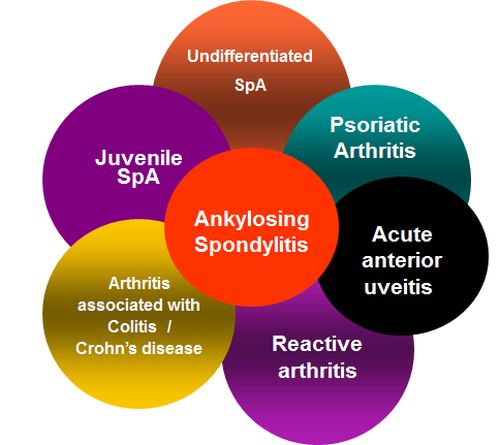Spondyloarthropathy and Enthesitis
Introduction
The Spondyloarthopathy concept was first described in Leeds in the early 1970s.
The description was based on the fact that certain diseases occurred together in the same patient or certain diseases ran in some families.
John Moll and Verna Wright who described the Spondyloarthropathy concept noted that these disorders were associated with a tendency towards inflammation in the spine hence the term "spondylo". Much of the spinal disease was evidently linked to enthesopathy on x-ray
These diseases included psoriasis, psoriatic arthritis, ankylosing spondylitis, Crohns Disease, ulcerative colitis and uveitis.

|
| The original Spondyloarthropathy Concept was based on the observation that some conditions caused inflammation in the spine. A unifying understanding of why these diseases occurred did not exist until recently. Many doctors and scientists now consider that the unifying concept for the Spondyloarthropathies is that disease localises to sites of high mechanical stressing at entheses and related sites |
They also noted that some patients were also prone to peripheral enthesitis and had negative tests for rheumatoid arthritis.
In the 1990s research in Leeds showed that enthesitis was much commoner than previously recognised in the SpA diseases.
This lead to the enthesitis theory of disease which has been repeatedly shown to hold up in animal models of SpA.
The page summarise studies showing that enthesopathy is the most common abnormality in the skeleton in patients with the related Spondyloarthropathies. The whole Spondyloarthropathy concept can now be linked to enthesitis and inflammation at sites of repeated mechanical stressing.
Spondyloarthropathy and Enthesitis-the silent epidemic
Ultrasound studies have shown that there is a large burden of clinically hidden or silent enthesopathy in the lower limbs in Spondyloarthropathy patients [1].
Psoriasis
Studies have shown that enthesopathy is the commonest lesion in the skeleton in psoriasis subjects [2].
Eye Disease
Patients with anterior uveitis also have silent enthesopathy in the lower limbs [3].
Crohns Disease and Ulcerative Colitis.
Ultrasound studies have shown that enthesopathy is very common in these conditions [4].
Enthesitis is a well-recognised clinical feature of Reactive Arthritis [5].
The Future
Studies are on-going to determine whether the silent epidemic of enthesopathy may be used to predict who will develop arthritis. This might have implications for early treatment.
The enthesitis concept will be key to a better classification of both peripheral and axial Spondyloarthropathy
References




Resources
Assessment of SpondyloArthritis international Society Mission statement